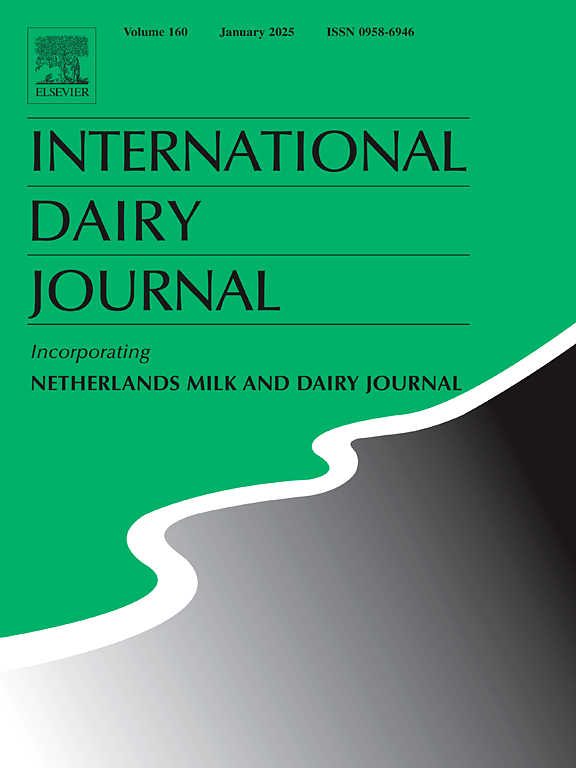乳制品生产线中的粪肠球菌和粪肠球菌:抗生素耐药性和毒力特征
IF 3.1
3区 农林科学
Q2 FOOD SCIENCE & TECHNOLOGY
引用次数: 0
摘要
本研究调查了两家奶牛场中粪肠球菌和粪肠球菌的流行情况、耐药性和毒力。经PCR和BD Phoenix自动检测系统确认,219份样品中有42份存在粪肠杆菌(26/ 42,62%)或粪肠杆菌(16/ 42,38%)污染。在48%的肠球菌分离株中发现抗生素耐药,其中阿奇霉素(31%粪肠球菌,27%粪肠球菌)、红霉素(44%粪肠球菌,27%粪肠球菌)和四环素(19%粪肠球菌,12%粪肠球菌)耐药率较高。环丙沙星和万古霉素耐药性罕见(两者均低于10%)。值得注意的是,25%的耐药菌株为多重耐药(MDR),多重抗生素耐药(MAR)指数为0.3。毒力分析显示,42株分离株中69%含有至少一种esp或efaA基因,或两种基因都是肠球菌发病所必需的,而67%的分离株产生生物膜。大多数耐药菌株(60%)产生生物膜并携带相关的毒力基因。综上所述,耐抗生素的粪肠杆菌和粪肠杆菌沿乳制品生产线可能构成潜在的食品安全和公共卫生问题,因为它们存在于生物膜群落中,增强了抗生素耐药性并促进了水平基因转移。本文章由计算机程序翻译,如有差异,请以英文原文为准。
Enterococcus faecalis and E. faecium in dairy production line: Antibiotic resistance profile and virulence characteristics
This study investigated the prevalence, antimicrobial resistance and virulence of Enterococcus faecalis and E. faecium, in two dairy plants, posing public health risks. Overall, from 219 samples, 42 were contaminated with E. faecium (26/42, 62%) or E. faecalis (16/42, 38%), which confirmed via PCR and BD Phoenix automated system. Antibiotic resistance was found in 48% of the enterococci isolates, with high rates for azithromycin (31% E. faecalis, 27% E. faecium), erythromycin (44% E. faecalis, 27% E. faecium), and tetracycline (19% E. faecalis, 12% E. faecium). ciprofloxacin and vancomycin resistances were rare (below 10% for both). Notably, 25% of the resistant isolates were multidrug-resistant (MDR) with a Multiple Antibiotic Resistance (MAR) index of 0.3. Virulence analysis showed that 69% of 42 isolates harboured at least one esp or efaA, or both genes which are essential for enterococcal pathogenesis, while 67% of isolates produced biofilms. Most antibiotic-resistant isolates (60%) were biofilm producers and harboured associated virulence genes. In conclusion, antibiotic-resistant E. faecalis and E. faecium along the dairy production line might pose potential food safety and public health concerns, due to their presence in biofilm communities, which enhance antibiotic resistance and facilitate horizontal gene transfer.
求助全文
通过发布文献求助,成功后即可免费获取论文全文。
去求助
来源期刊

International Dairy Journal
工程技术-食品科技
CiteScore
6.50
自引率
9.70%
发文量
200
审稿时长
49 days
期刊介绍:
The International Dairy Journal publishes significant advancements in dairy science and technology in the form of research articles and critical reviews that are of relevance to the broader international dairy community. Within this scope, research on the science and technology of milk and dairy products and the nutritional and health aspects of dairy foods are included; the journal pays particular attention to applied research and its interface with the dairy industry.
The journal''s coverage includes the following, where directly applicable to dairy science and technology:
• Chemistry and physico-chemical properties of milk constituents
• Microbiology, food safety, enzymology, biotechnology
• Processing and engineering
• Emulsion science, food structure, and texture
• Raw material quality and effect on relevant products
• Flavour and off-flavour development
• Technological functionality and applications of dairy ingredients
• Sensory and consumer sciences
• Nutrition and substantiation of human health implications of milk components or dairy products
International Dairy Journal does not publish papers related to milk production, animal health and other aspects of on-farm milk production unless there is a clear relationship to dairy technology, human health or final product quality.
 求助内容:
求助内容: 应助结果提醒方式:
应助结果提醒方式:


